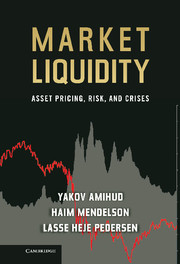Book contents
- Frontmatter
- Contents
- Acknowledgments
- Introduction and Overview of the Book
- Part I The Effect of Liquidity Costs on Securities Prices and Returns
- Part II Liquidity Risk
- Chapter 4 Illiquidity and Stock Returns:Cross-Section and Time-Series Effects
- Illiquidity and Stock Returns Cross-Section and Time-Series Effects*
- Chapter 5 Asset Pricing with Liquidity Risk
- Part III Liquidity Crises
- References for Introductions and Summaries
- Index
Chapter 5 - Asset Pricing with Liquidity Risk
Summary and Implications
Published online by Cambridge University Press: 05 December 2012
- Frontmatter
- Contents
- Acknowledgments
- Introduction and Overview of the Book
- Part I The Effect of Liquidity Costs on Securities Prices and Returns
- Part II Liquidity Risk
- Chapter 4 Illiquidity and Stock Returns:Cross-Section and Time-Series Effects
- Illiquidity and Stock Returns Cross-Section and Time-Series Effects*
- Chapter 5 Asset Pricing with Liquidity Risk
- Part III Liquidity Crises
- References for Introductions and Summaries
- Index
Summary
Market-wide liquidity shocks are a source of systematic risk in securities markets, which affect investors’ wealth and ability to trade. Risk-averse investors price this risk, requiring higher expected returns on assets with higher exposure to liquidity-related risk. This is the proposition of Acharya and Pedersen, who present a liquidity-adjusted Capital Asset Pricing Model (CAPM) that accounts for the risk of systematic shocks to liquidity. For example, in the Global Financial Crisis of 2008–2009, investors experienced severe reductions in liquidity and feared that liquidity would dry up even more; this is the liquidity risk that Acharya and Pedersen model. According to their model, liquidity risk reduces prices and increases the required return, thus contributing to the large drop in prices during the global financial crisis, and it can help explain why prices rebounded so strongly when, starting in March 2009, the liquidity crisis eased off.
In the model, diversified investors price systematic risk while they diversify away the idiosyncratic (i.e., unsystematic) risk. Investors care about their net return, which equals gross returns generated by the assets minus the cost of trading the assets. Thus, the risk of the net return is affected by the risk of both the gross returns and the trading costs. Indeed, trading costs vary significantly over time as seen in Figures 5.1 and PII.1. An asset's gross returns and transaction costs are exposed to two market-wide risk factors: gross market returns and market-wide shocks to transaction costs (or illiquidity costs). The sensitivity, or the beta, of the asset's net returns to these two market-wide risk factors determines the systematic risk to which the investor is exposed, and for which the investor demands a risk premium as compensation.
- Type
- Chapter
- Information
- Market LiquidityAsset Pricing, Risk, and Crises, pp. 137 - 184Publisher: Cambridge University PressPrint publication year: 2012
- 9
- Cited by

